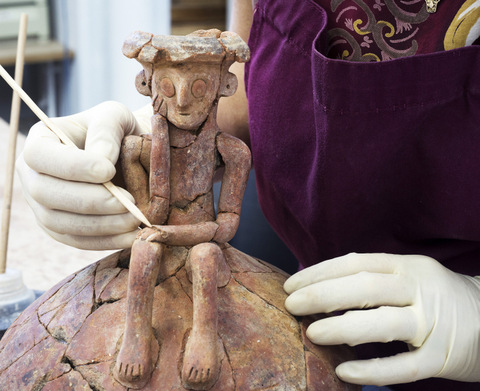.
The vessel was discovered together with daggers, an axe head and arrowheads that were apparently buried as funerary offerings for one of the respected members of the ancient settlement

Photographer: Clara Amit
A small extraordinary jug from the Middle Bronze Age was revealed with the assistance of pupils in the Land of Israel and Archaeology matriculation stream in an Israel Antiquities Authority archaeological excavation that was recently conducted in the city of Yehud prior to the construction of residential buildings.
According to Gilad Itach, excavation director on behalf of the Israel Antiquities Authority, “It literally happened on the last day of the excavation when right in front of our eyes and those of the excited students an unusual ceramic vessel c. 18 cm high was exposed that bears the image of a person. It seems that at first the jug, which is typical of the period, was prepared, and afterwards the unique sculpture was added, the likes of which have never before been discovered in previous research. The level of precision and attention to detail in creating this almost 4,000 year old sculpture is extremely impressive. The neck of the jug served as a base for forming the upper portion of the figure, after which the arms, legs and a face were added to the sculpture. One can see that the face of the figure seems to be resting on its hand as if in a state of reflection”. Itach added, “It is unclear if the figure was made by the potter who prepared the jug or by another craftsman”.
Efrat Zilber, supervisor responsible for coordinating the Land of Israel and Archaeology matriculation stream in the Ministry of Education emphasized that “the archaeological excavations provide an opportunity for an intensive and direct experience that connects the pupils with our country’s past. An experiential learning experience involving research methods employed in archaeology takes place while revealing the artifacts. The pupils meet experts in a variety of fields who share their knowledge with them, enrich the pupils while also enriching their world”.
In addition to the unique pottery vessel, other vessels and metal items were found such as daggers, arrowheads, an axe head, sheep bones and what are very likely the bones of a donkey. According to Itach, “It seems that these objects are funerary offerings that were buried in honor of an important member of the ancient community. It was customary in antiquity to believe that the objects that were interred alongside the individual continued with him into the next world. To the best of my knowledge such a rich funerary assemblage that also includes such a unique pottery vessel has never before been discovered in the country”.
In addition, a variety of evidence regarding the kind of life that existed there 6,000 years ago was exposed – among other things, pits and shafts were revealed that contained thousands of fragments of pottery vessels, hundreds of flint and basalt implements, animal bones, and a churn which is a unique vessel that was widely used in the Chalcolithic period for making butter.
The pupils of the Land of Israel and Archaeology matriculation stream participate in excavations as part of the new training course offered by the Israel Antiquities Authority and the Ministry of Education, which seeks to connect them with the past and help prepare the archaeologists of the future. Students who choose this course of study as part of their alternative evaluation for high school matriculation, take part in a week of excavation. They experience the variety of roles involved in the excavation, discuss questions regarding research and archaeological considerations and document the excavations in a field diary as part of their research work.
“Suddenly I saw many archaeologists and important people arriving who were examining and admiring something that was uncovered in the ground” recalls Ronnie Krisher, a pupil in the Land of Israel and Archaeology stream in the Roeh religious girls high school in Ramat Gan. “They immediately called all of us to look at the amazing statuette and explained to us that this is an extremely rare discovery and one that is not encountered every day. It is exciting to be part of an excavation whose artifacts will be displayed in the museum”.
”.
Additional Articles ...